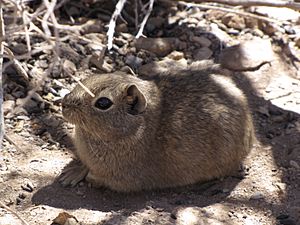Southern mountain cavy facts for kids
Quick facts for kids Southern mountain cavy |
|
|---|---|
 |
|
| Conservation status | |
| Scientific classification |
The southern mountain cavy (also known as Microcavia australis) is a small, furry animal that lives in South America. It's a type of rodent, just like a guinea pig, and belongs to the Caviidae family.
Contents
What They Look Like
Southern mountain cavies are rodents without tails. They have short, speckled fur that is a mix of grey and yellow. Their belly fur is a lighter, pale grey. When they are fully grown, they are about 20 cm (7.9 in) long. They usually weigh between 200 and 326 g (7.1 and 11.5 oz), which is about as much as a small can of soda.
These cavies have big eyes with a clear white ring around them. They also have small, round ears. Female cavies have four teats, which they use to feed their young.
Where They Live
Southern mountain cavies mostly live in Argentina. You might also find them in some parts of nearby Chile and Bolivia. They live across most of western and southern Argentina.
They prefer dry and semi-dry flat lands. You can often find them near rivers or in areas with lots of thorny bushes.
Daily Life and Habits
Southern mountain cavies are active during the day, which means they are diurnal. They come out of their burrows when the sun rises and stay busy all day. If the weather gets too hot, they might take a break.
What They Eat
These cavies eat leaves, fruits, and other parts of plants. They especially like mesquite and Capparis plants. They are good climbers and can even climb trees up to 4 m (13 ft) high to reach tasty leaves! If food is hard to find, they will eat almost any plant, even chewing on the bark of creosote bushes.
Their Homes
Southern mountain cavies live together in groups called colonies. They dig burrows in the ground, and a colony can have anywhere from 4 to 38 cavies living in it. These burrows can be very large. One burrow was found to have 26 entrances and stretched for a total length of 42 m (138 ft)!
Male cavies can sometimes be aggressive towards each other. This helps them set up a pecking order, or a "boss" system, within the burrow. However, when the weather is bad or there aren't many safe places to hide, the cavies, especially the females, might huddle together to stay warm. Female cavies have also been seen helping each other nurse their babies.
Staying Safe
Many animals hunt southern mountain cavies. Their natural predators include owls, hawks, grisons, foxes, and skunks. When they sense danger, they make low-pitched alarm calls to warn the other cavies. They also have other calls: a high-pitched cry when they are scared, and soft, quiet squeaks they use when they are chasing each other or during courtship.
Life Cycle
Southern mountain cavies usually have babies between August and April. After about 54 days, the mother gives birth to a litter of one to five young. The babies weigh about 30 g (1.1 oz) when they are born. They are amazing because they can run almost right away!
They stop drinking their mother's milk when they are about three weeks old. Female cavies can become ready to have their own babies when they are only 40 to 50 days old.
See also
 In Spanish: Cuis chico para niños
In Spanish: Cuis chico para niños


